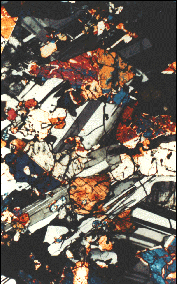About the Astromaterials Acquisition and Curation Office
Our mission is to protect, preserve, and distribute samples for study from the Moon, Mars, and interplanetary space in support of solar system exploration. These sample collections include:
- Lunar rocks and regolith returned by the Apollo missions
- Dust particles collected from the stratosphere
- Solar Wind samples collected during the exposer of ultrapure materials to the solar wind at the Earth-Sun L1 point
- Meteorites recovered by the U.S. Antarctic Search for Meteorites
- Space-exposed surfaces retrieved from satellites or spacecraft
- Cometary and Interstellar samples collected from Comet and Interstellar dust stream
Maintaining samples in a pure state is critical to extracting scientific information from these unique, and often very small, samples. Equally important, however, is making the collection available for scientific study and education, because it is these activities that give the samples their true value. It is also wise to reserve portions of samples for future studies that will become possible with new or improved ideas and techniques.
Keeping Cosmic Dust samples clean and pure requires a laboratory that is bathed in highly filtered air.
Keep the samples pure
Much of the research done on extraterrestrial samples involves measuring very small differences in composition; even tiny amounts of Earth materials can contaminate and ruin scientific measurements. Contamination could be caused by airborne particles getting into the sample or by reaction of the sample with the Earth's atmosphere. Examples:
The amount of lead in a solder droplet exceeds the amount of lead in all 382 kilograms of lunar samples. It happens that lead resulting from radioactive decay of uranium is one of the indicators used to measure the age of rocks; thus, any Earth-based lead is common in many electrical devices routinely used in laboratories but must be carefully avoided during sample curation. Moon soil contains pure iron metal, which would quickly rust in Earth's atmosphere, and water-free glass, which reacts with moisture to form clays. Samples must be kept under inert gas.
Our various curatorial laboratories deal with contamination in slightly different ways. Generally, airborne particulate contamination is controlled by air filtration, special clothing on personnel, restricting the types of materials that are used in the laboratory for tools and containers, and scrupulously cleaning the tools and containers that touch the samples. A special team of technicians cleans and certifies tools used in the laboratories. To keep samples from reacting with the Earth's atmosphere, samples are enclosed in gloved cabinets filled with pure nitrogen.
Preserve accurate information about the samples
Great effort is made to document all procedures performed upon samples using written descriptions, photographs and standardized processing procedures. Over the years, a rock may be subdivided into several hundred small pieces, and the orientation or relationship of all the pieces to each other will be recorded in a standard way. The scientific value of a samples is greatly increased when these spatial relationships are known. This is particularly true of space radiation studies where the depth from the surface of the rock is critical. In addition to purely scientific information, accounting data, such as sample location or weight is also recorded. The curators know where the samples are and how they are being used. Computer data bases are updated daily based on work done in curatorial laboratories and information received from scientific investigators.
Examine and classify samples
Newly obtained samples are examined and classified, so that scientists can use the samples appropriately. For large samples, such as lunar and meteorite samples, examination may consist of observation through the binocular microscope and the preparation of a thin section, from which mineral composition can be identified. For samples too small to see with ordinary means, such as cosmic dust and space-dust impact craters, additional examination may be done with a scanning electron microscope which reveals the particle shape and chemical composition. For some samples, such as the remaining unopened lunar soil cores, the opening, careful dissection and description may take months.
A thin section of a sample, when viewed under a microscope, with light transmitted through it, clearly shows the mineral grains, their sizes and shapes, and how they fit together within the rock. Such information is used to classify the rock and understand its history.
Share information on new samples
Information about new samples is valuable only if it is shared with scientists who need samples for their research. Accordingly, we publish three newsletters (lunar, meteorite, cosmic dust) and one catalog regularly, plus special catalogs as the need arises. Specific information concerning samples can be quickly compiled via computerized databases. Sample information is also shared through presentations at scientific meetings.
Prepare & distribute samples for research and education
Extraterrestrial samples are prepared for shipment in clean room laboratories. Samples are shipped directly to approved scientific researchers. For lunar and meteorite samples, scientific review committees have set aside certain samples for educational use. These samples were prepared into sets with explanatory teaching materials, and are loaned to schools and colleges by the Curator or through the Public Affairs Office.
The curatorial staff plans to build on past experience in preparing for the technological challenges of the future. Anticipated challenges include improvements in materials used to touch samples, container seals, manipulation and storage of samples at low temperature and low pressure, cost efficiencies in managing the samples, and rapid, innovative distribution of samples and sample information to scientists and educators. Rocks, soil and ices from Mars and comets pose special challenges to collect, transport, store and study under their natural environmental conditions of extremely low temperatures and pressures. For comets, temperatures of 130 K (-226 F) and vacuum conditions may be appropriate; for Mars 230 K ( -46 F) and a pressure equal to only 1% of Earth's may be required. Future samples may come from: Moon, Mars, Space Station Cosmic Dust Collection Facility, Space-exposed hardware, comets, asteroids, other stratospheric dust samples such as volcanic ash, and special Earth samples.

